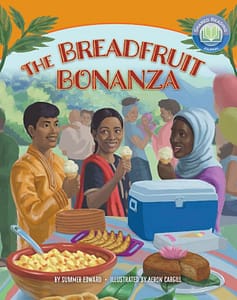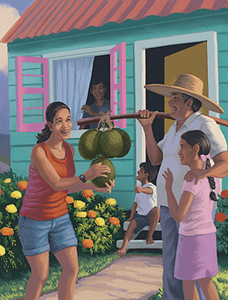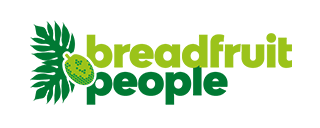Organisation

Author, Children’s Editor, Founder of Anansesem
Summer Edward is a Ginkgo Prize longlisted Trinidadian American author,
editor, and literacy specialist. Her recent children’s book, The Breadfruit
Bonanza, illustrated by Aeron Cargill, is the story of a young Indo-
Trinidadian girl who mobilizes her community in order to tackle hunger in
their village by planting breadfruit trees. Visit Summer’s website to learn
more: www.summeredward.com.
What inspired your love for breadfruit?
I first encountered breadfruit trees when I was a child growing up in Trinidad since they’re a pretty common sight on the island. As an adult, when I moved back to Trinidad after living in the U.S. for many years, I rediscovered breadfruit, and old family memories associated with preparing and eating breadfruit dishes resurfaced. There is something special about rediscovering, after a long absence, a certain tree and type of food that were once taken-for-granted features of your daily existence. The dear place that breadfruit holds in my childhood memories is what inspires my fondness for it.
What is one thing you would like people to know about breadfruit?
This may sound frivolous, but breadfruit trees have a lot of ornamental charm. Their beautiful, glossy, dark, distinctive leaves have made them a recurring motif in fine art, arts and crafts projects, fabric art, and even interior design. And the canopies of breadfruit trees can be quite stunning.
When did you start working with the crop and why?
I started doing research for The Breadfruit Bonanza in the early months of 2020. At that time, it was the peak of the pandemic and there was all this talk about the impact of Covid on food security. I came across a newspaper article about a tree-planting initiative in Trinidad, the Breadfruit Trees Project, the goal of which was to combat malnutrition and food insecurity with breadfruit. That’s what initially prompted me to start learning more about the crop.
How have you been working or affiliated with the crop?

So far, my ‘work’ with breadfruit has been writing a children’s book that I hope will help young people understand that they can do something to make sure everyone has access to food. Sustainable agriculture and the creation of sustainable food systems don’t have to be undertakings for adults only; kids can and should participate too, not only because of what they can contribute, but also because there are many immaterial, positive things they can gain by getting involved.
The Breadfruit Bonanza is also a story about the power of collective action and altruism, which is a through line in all of the real-life breadfruit production, revitalization, and conservation projects I’ve read and heard about. Although I’m not someone who’s on the ground doing hands-on work with breadfruit—like a farm worker or a crop scientist—I get to transmit the same important values of community and altruism to young people through a work of fiction inspired by all of the great things currently happening in the breadfruit community.
What is your favourite breadfruit dish?
Oil Down, a dish that’s a staple of Trinbagonian cuisine. I find it delicious when done well —there’s definitely some technique to it! To prepare oil down, you mix together vegetables, any kind of salted meat/fish, green figs (in the U.S. these would be called ‘green bananas’), dasheen bush (i.e. the leaves of the dasheen plant, which is known as the taro plant in the U.S.), and chunks of breadfruit, and you steam (some people say stew) everything in coconut milk with lots of seasoning. I only just learned recently that the dish is called ‘oil down’ because the oil from the coconut milk and meat juices settles at the bottom of the cooking pot.
In your opinion do you think breadfruit is a worthy opponent in the battle to conquer world hunger?
Breadfruit is the gift that keeps on giving. An easy-to-plant tree, it yields a large subsistence crop (more than 200 fruit in a single season) of starchy, nutrient-rich, gluten-free food that provides a sustainable source of nutrition. When I was writing The Breadfruit Bonanza, one thing I discovered during my research is just how versatile breadfruit is, in the sense that it can be prepared and eaten at all stages of development and maturity, and there are literally scores of ways of cooking it. Additionally, studies have found that breadfruit is resilient in the face of climate change and grows particularly well in regions where food insecurity is high.
What is one important message you would like people to know or learn about breadfruit?
Breadfruit trees aren’t just valuable for their role in fighting hunger, which is what The Breadfruit Bonanza is about. There’s also something treasurable in the fact that across many cultures, there are mythological, symbolic, traditional, cultural, and religious associations that have historically shaped people’s relationship with breadfruit. The larger story of breadfruit is the story of the spiritual, inner richness that nature adds to human lives. I hope that more people will become curious about this intangible heritage of breadfruit and grow to respect it.

